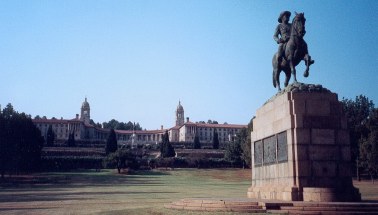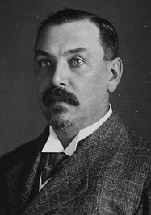The Union Buildings and the Union of South Africa.1910


Image 1: The Union Buildings on Meintjies Kop in Pretoria.
The Union Building that was built on Meintjieskop, Arcadia, named after Stephanus Jacobus Meintjies. Arcadia was
farmland, originally belonging to Andries Francois du Toit, who then sold it.The cornerstone was laid in November 1910
by the Duke of Connaught. The buildings were completed in 1913. These buildings, built from light sandstone, designed
by the architect Sir Herbert Baker in the English monumental style and many old Dutch architectural motifs, are 285 m
long.
The semicircular building has 2 wings - these 2 wings represent the union of the Afrikaners and the British. Together
they formed the Union of South Africa. Dominating the summit of Meintjes Kop, the building, with it's great amphitheatre,
can house over 1500 officials.
Image 2: General Louis Botha. He was the first South African presidential leader, the then Premier of the Union of
South Africa, to take office in the Union Buildings, known as the official seat of the South African Government.
The Voortrekker Monument is the second great building and can be seen from almost any location in Pretoria.
The Union of South Africa
Former member of the British Commonwealth of Nations. It came into existance on May 31, 1910. On May 31, 1961,
after a referendum, it became the Republic of South Africa.
The Peace of Vereeniging was signed on May 31, 1902. Two Republics, Transvaal and the Orange Free
State, became crown colonies of the British. After peace had been signed there were four principal governments in South Africa, in the Cape and Natal, governments
responsible to electorates, in the Transvaal and Orange River Sovereignty, governments responsible only to the British High Commissioner. Lord Selborne in I907 brought the
question of South African Union on to the plane of practical politics.
In May 1908 a conference of South African Governments invited the legislatures of all the Colonies to nominate delegates to a National Convention for drafting a
constitution for South Africa.





The Union of South Africa established
Between 1908 and 1909, 33 delegates - 12 from the Cape Colony, 8 from Transvaal, 5 from the Orange River Colony, 5 from Natal and 3 from Rhodesia met in
National Convention (Convention on the Closer Union of South Africa or the Closer Union Convention)
in Durban (12 October to 5 November 1908), Cape Town (23 November to 18 December 1908, 11 January to 3 February 1909) and Bloemfontein (3 May to 11 May 1909).
By the end of the convention they produced a draft constitution that was substantially accepted by all the South African Colonies. The draft which took the form of an
imperial Bill presented to the British Parliament was a skilful and practical plan for transforming the four Colonies of South Africa into a united nation.
In London, 53 amendments were made to the Bill, most of which were procedural and not substantive, and Parliament passed the constitution in essentially the
same form it had been submitted by the National Convention. It received royal assent on 20 September 1909. It became the South Africa Act,
South Africa's constitution between 1910 and 1961.
Indigenous black African, Coloured, and Asian representatives were excluded from the process.
In response to the constitutional convention, blacks held their own South African Native Convention in Bloemfontein. This led to the formation of
the South African Native National Congress founded on January 8, 1912.
It aimed to bring all Africans together as one people to defend their rights and freedoms. The organisation was renamed the ANC in 1923.
The Union of South Africa was established on May 31, 1910, with Louis Botha as the first prime minister and Jan Smuts as his deputy. In a few years it enabled him to
join hands with his old opponent General Smuts and establish a National Government in South Africa, which at last brought the more moderate
elements of British and Dutch into one party.




Flag of the Cape Colony 1875-1910. Flag of Natal 1843 – 1910. Flag of Transvaal. Flag of the Orange Free State 1854 – 1902
Pretoria became the administrative capital, Cape Town the legislative, and Bloemfontein the judicial.
The first Union cabinet

The first cabinet of the Union of South Africa in 1910 under the leadership of Prime Minister Louis Botha Back: J. B. M. Hertzog, Henry Burton,
F. R. Moor, C. O'Grady Gubbins, Jan Smuts, H. C. Hull, F. S. Malan, David Graaff Front: J. W. Sauer, Louis Botha, Abraham Fischer.
Union Defence Force (UDF)
The Union Defence Force (UDF) was the military of South Africa from 1 July 1912, when the Defence Act (No 13 of 1912) took effect, two years
after the creation of the Union of South Africa, until 1957 when it was reorganised and renamed the South African Defence Force.